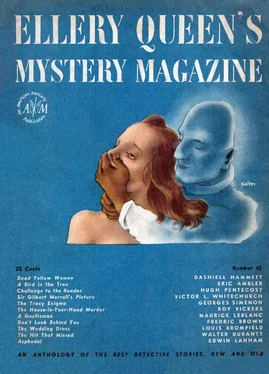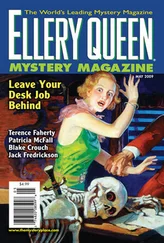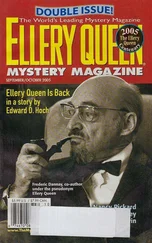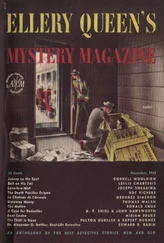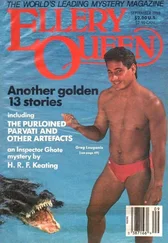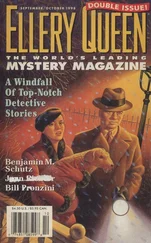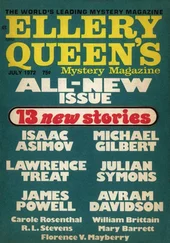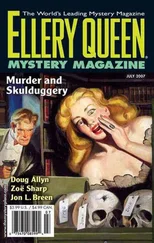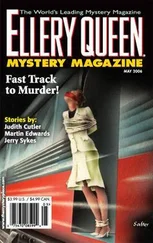Эрик Эмблер - Ellery Queen’s Mystery Magazine. Vol. 9, No. 42, May 1947
Здесь есть возможность читать онлайн «Эрик Эмблер - Ellery Queen’s Mystery Magazine. Vol. 9, No. 42, May 1947» весь текст электронной книги совершенно бесплатно (целиком полную версию без сокращений). В некоторых случаях можно слушать аудио, скачать через торрент в формате fb2 и присутствует краткое содержание. Город: New York, Год выпуска: 1947, Издательство: The American Mercury, Жанр: Классический детектив, Детектив, на английском языке. Описание произведения, (предисловие) а так же отзывы посетителей доступны на портале библиотеки ЛибКат.
- Название:Ellery Queen’s Mystery Magazine. Vol. 9, No. 42, May 1947
- Автор:
- Издательство:The American Mercury
- Жанр:
- Год:1947
- Город:New York
- ISBN:нет данных
- Рейтинг книги:3 / 5. Голосов: 1
-
Избранное:Добавить в избранное
- Отзывы:
-
Ваша оценка:
- 60
- 1
- 2
- 3
- 4
- 5
Ellery Queen’s Mystery Magazine. Vol. 9, No. 42, May 1947: краткое содержание, описание и аннотация
Предлагаем к чтению аннотацию, описание, краткое содержание или предисловие (зависит от того, что написал сам автор книги «Ellery Queen’s Mystery Magazine. Vol. 9, No. 42, May 1947»). Если вы не нашли необходимую информацию о книге — напишите в комментариях, мы постараемся отыскать её.
Ellery Queen’s Mystery Magazine. Vol. 9, No. 42, May 1947 — читать онлайн бесплатно полную книгу (весь текст) целиком
Ниже представлен текст книги, разбитый по страницам. Система сохранения места последней прочитанной страницы, позволяет с удобством читать онлайн бесплатно книгу «Ellery Queen’s Mystery Magazine. Vol. 9, No. 42, May 1947», без необходимости каждый раз заново искать на чём Вы остановились. Поставьте закладку, и сможете в любой момент перейти на страницу, на которой закончили чтение.
Интервал:
Закладка:
Ellery Queen’s Mystery Magazine. Vol. 9, No. 42, May 1947

Dead Yellow Women
by Dashiell Hammett
Dashiell Hammett is branching out. True, he has not written a novel since THE THIN MAN which was published thirteen years ago ( it’s hard to believe, isn’t it, that THE THIN MAN first appeared so long ago?), but the author of such fabulous detective novels as THE MALTESE FALCON and THE GLASS KEY can rest on his laurels for a long, long time — especially if his success in so-called “supplementary fields” keeps increasing with the years. For surely Mr. Hammett has performed the literary hat trick with a vengeance: his books continue to sell in reprint editions of all prices; his movie credits are still associated with Class A productions; and his radio record is reaching an all-time high — at the time of this writing there are no less than three Hammett shows on the air (The Thin Man, The Fat Man, and Sam Spade) and rumors are flying that The Continental Op will join his brothers-of-the-blood on the ether any week now. And still Dashiell Hammett is branching out. From the grapevine comes the report that Mr. Hammett is writing his first play for Broadway. That is good news indeed! Hammett has it in him to write a smash hit — remember his powerful screenplay of Lillian Hellman’s WATCH ON THE RHINE? Will Mr. Hammett write a serious play? He can do it. Or will he stick to his first love — detection-and-melodrama? Selfishly, we hope Mr. Hammett makes his debut as a dramatist in the genre to which he has already made so important a contribution...
It is many years since Mr. Hammett has written a new short story. He once told your Editor he might never go back to the short-story form. We think he will, and until that happy day we shall continue to unearth Mr. Hammett’s buried treasures of the past and bring you such “unknown” stories as the Continental Op’s early adventure titled “Dead Yellow Women.”
Copyright 1925, by Pro-Distributors Publishing Co., Inc.
She was sitting straight and stiff in one of the Old Man’s chairs when he called me into his office — a tall girl of perhaps twenty-four, broad-shouldered, deep-bosomed, in mannish grey clothes. That she was Oriental showed only in the black shine of her bobbed hair, in the pale yellow of her unpowdered skin, and in the fold of her upper lids at the outer eye-corners, half hidden by the dark rims of her spectacles. But there was no slant to her eyes, her nose was almost aquiline, and she had more chin than Mongolians usually have. She was modern Chinese-American from the flat heels of her tan shoes to the crown of her untrimmed felt hat.
I knew her before the Old Man introduced me. The San Francisco papers had been full of her affairs for a couple of days. They had printed photographs and diagrams, interviews, editorials, and more or less expert opinions from various sources. They had gone back to 1912 to remember the stubborn fight of the local Chinese — mostly from Fokien and Kwangtung, where democratic ideas and hatred of Manchus go together — to have her father kept out of the United States, to which he had scooted when the Manchu rule flopped. The papers had recalled the excitement in Chinatown when Shan Fang was allowed to land — insulting placards had been hung in the streets, an unpleasant reception planned. But Shan Fang had fooled the Cantonese. Chinatown had never seen him. He had taken his daughter and his gold — presumably the accumulated profits of a life-time of provincial misrule — down to San Mateo County, where he had built what the papers described as a palace on the edge of the Pacific. There he had lived and died in a manner suitable to a Ta Jen and a millionaire.
So much for the father. For the daughter — this young woman who was coolly studying me as I sat down across the table from her: she had been ten-year-old Ai Ho, a very Chinese little girl, when her father had brought her to California. All that was Oriental of her now were the features I have mentioned and the money her father had left her. Her name, translated into English, had become Water Lily, and then, by another step, Lillian. It was as Lillian Shan that she had attended an eastern university, acquired several degrees, and published a book on the nature and significance of fetishes, whatever all that is or are.
Since her father’s death, in 1921, she had lived with her four Chinese servants in the house on the shore, where she had written her first book and was now at work on another. A couple of weeks ago, she had found herself stumped, so she said — had run into a blind alley. There was, she said, a certain old cabalistic manuscript in the Arsenal Library in Paris that she believed would solve her troubles for her. So she had packed some clothes and, accompanied by her maid, a Chinese woman named Wang Ma, had taken a train for New York, leaving the three other servants to take care of the house during her absence.
On the train between Chicago and New York, the key to the problem that had puzzled her suddenly popped into her head. Without pausing even for a night’s rest in New York, she had turned around and headed back for San Francisco. At the ferry here she had tried to telephone her chauffeur to bring a car for her. No answer. A taxicab had carried her and her maid to her house. She rang the door-bell to no effect.
When her key was in the lock the door had been suddenly opened by a young Chinese man — a stranger to her. He had refused her admittance until she told him who she was. He mumbled an unintelligible explanation as she and the maid went into the hall.
Both of them were neatly bundled up in some curtains.
Two hours later Lillian Shan got herself loose — in a linen closet on the second floor. Switching on the light, she started to untie the maid. She stopped. Wang Ma was dead. The rope around her neck had been drawn too tight.
Lillian Shan went out into the empty house and telephoned the sheriff’s office in Redwood City.
Two deputy sheriffs had come to the house, had listened to her story, had poked around, and had found another Chinese body — another strangled woman — buried in the cellar. Apparently she had been dead a week or a week and a half; the dampness of the ground made more positive dating impossible. Lillian Shan identified her as another of her servants — Wan Lan, the cook.
The other servants — Hoo Lun and Yin Hung — had vanished. Of the several hundred thousand dollars’ worth of furnishings old Shan Fang had put into the house during his life, not a nickel’s worth had been removed. There were no signs of a struggle. Everything was in order. The closest neighboring house was nearly half a mile away. The neighbors had seen nothing, knew nothing.
That’s the story the newspapers had hung headlines over, and that’s the story this girl, sitting very erect in her chair, speaking with businesslike briskness, told the Old Man and me.
“I am not at all satisfied with the effort the San Mateo County authorities have made to apprehend the murderer or murderers,” she wound up. “I wish to engage your agency.”
“Have you any idea of your own on the murders, Miss Shan?” I asked.
“I have not.”
“What do you know about the servants — the missing ones as well as the dead?”
“I really know little or nothing about them.” She didn’t seem very interested. “Wang Ma was the most recent of them to come to the house, and she has been with me for nearly seven years.”
Читать дальшеИнтервал:
Закладка:
Похожие книги на «Ellery Queen’s Mystery Magazine. Vol. 9, No. 42, May 1947»
Представляем Вашему вниманию похожие книги на «Ellery Queen’s Mystery Magazine. Vol. 9, No. 42, May 1947» списком для выбора. Мы отобрали схожую по названию и смыслу литературу в надежде предоставить читателям больше вариантов отыскать новые, интересные, ещё непрочитанные произведения.
Обсуждение, отзывы о книге «Ellery Queen’s Mystery Magazine. Vol. 9, No. 42, May 1947» и просто собственные мнения читателей. Оставьте ваши комментарии, напишите, что Вы думаете о произведении, его смысле или главных героях. Укажите что конкретно понравилось, а что нет, и почему Вы так считаете.
